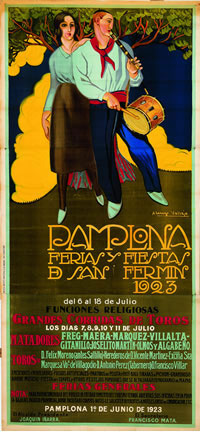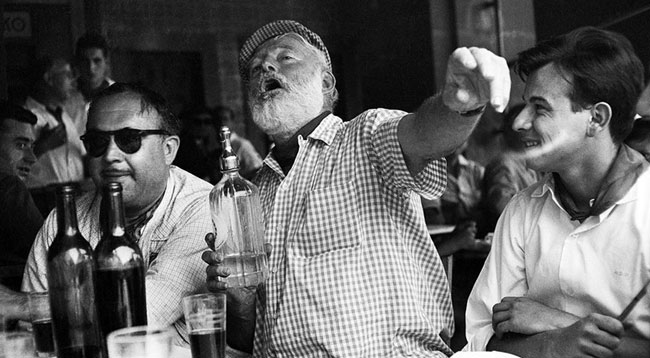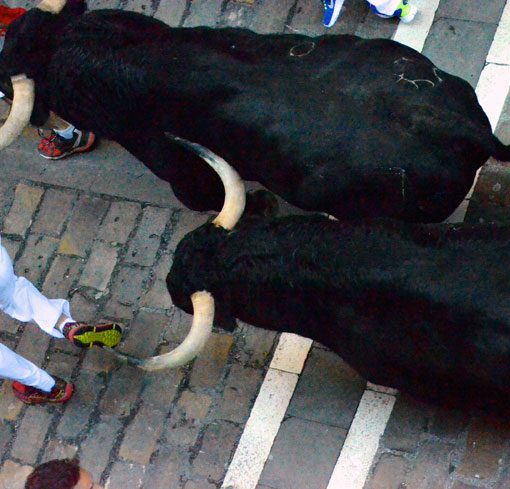Pamplona, 1923
It was extremely hot on that long ago 6th of July. From the very early morning hours, Pamplona, the capital of Navarra, had begun to prepare for its weeklong fiesta of bullfights, dances under the stars, concerts, fair rides and of course, “hearty drinking.” The shady terraces of the cafés Kutz, Suizo and Iruña were crowded with tables of men arguing over the merits of a handsome matador called Maera. Café conversation in Spain has always included politics, and that steamy July morning in 1923 was no exception. The government was about to be overthrown by a military coup d’état (13 September), and with strikes and violent street battles going on in other parts of the country, train loads of people from Barcelona, Bilbao, Zaragoza and San Sebastián where on their way to celebrate San Fermín in Pamplona. Native Pamploneses, strolling under the acaria trees in the Plaza del Castillo, wondered where “all of the out-of-towners would possibly find a place to sleep”.
That night, while fireworks exploded in the sky over the Plaza, a tall young man accompanied by a smiling blond woman entered the lobby of the Hotel La Perla. Although they had made reservations from Paris, Ernest Hemingway and his wife Hadley decided against staying there, probably due to the cost of the room, because in those days the Hotel La Perla was considered to be one of the more luxurious establishments in Pamplona, with a restaurant that served French cuisine. Fortunately, less expensive rooms that even a news correspondent could afford, were available on Eslava Street near the Plaza de San Francisco. (204 Hours of Fiesta).
Pamplona, 2018
95 years later things have changed to some extent. Hemingway’s “The Sun Also Rises” has attracted thousands visitors from around the world, doubling the population on a long weekend, but the dictators are long gone and the streets quiet except during fiesta. Navarra now has the third highest average income in Spain, along with low unemployment. The city of Pamplona is one of the most progressive cities in the country and a gastronomic destination in the north, joining San Sebastián-Donostia, Hondarriba and Bilbao.
But some things haven’t changed, at least not that much. It can still be extremely warm in early July if the Atlantic storms are not moving through, this is Green Spain afterall. Native Pamploneses still welcome everyone. The 5-star Grand Hotel La Perla is once again the most expensive establishment in the city, where few news correspondents today could afford to stay on their own. The small hotel on Eslava Street is gone but there is a small (28-room) 2-star Hotel Eslava in the same area at Plaza Virgen de la O, plus several comfortable 3 and 4-star properties in the old quarter and around the city from which to choose, a few more then when Hemingway first visited, but during the fiesta they can be expensive and in demand.
The “loads of people from Barcelona, Bilbao, Zaragoza, San Sebastián”, and now Madrid, sleep in the parks as they have always done, while most foreign visitors, especially those from Australia, the UK and Europe, without hotels rooms, end up staying at one of the local campgrounds, find a spot in one of the city parks, or end up on the streets of the old quarter.

Cafés Kutz and Suizo are not longer cafés. The tables at the classic Café Iruña, Bar Windsor, Casino Eslava and Txoto, where Rick and the Amigos de Pamplona hang out, are always crowded, but the converstations are somewhat different now and the tables filled with families. While the city is blessed with more then 300 restaurants, cafés and bars, during fiesta, unlike in Hemingway’s time, reservations are a must if you want to enjoy lunch in the comfort of an air-conditioned space, or dine at one of the city’s top restaurants like the Alhambra, Europa or the Michelin stared Rodero.
If you are planning on attending the fiesta this year, check out Sanfermín Tours to see what’s still available for the opening days of the fiesta.
